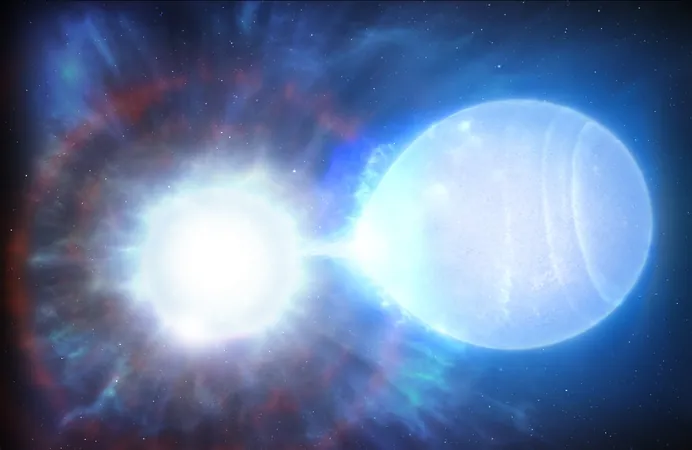
Nearby Star System on Collision Course: A Cosmic Catastrophe Awaits!
2025-04-04
Author: Ming
Astronomers from the University of Warwick have made a groundbreaking discovery just 150 light years from Earth: an extraordinary and rare binary star system composed of two high-mass white dwarfs hurtling toward a catastrophic end. These stellar partners are on a collision course to produce a type 1a supernova, which will be so luminous that it will outshine the full moon by a factor of ten in the night sky.
Type 1a supernovae are not just any cosmic explosions; they are vital astronomical phenomena. These supernovae serve as "standard candles" in cosmology, helping scientists measure cosmic distances with remarkable precision. This class of explosion occurs when a white dwarf, the dense remnant of a once-mighty star, accumulates too much mass from a companion star and ultimately succumbs to its own gravitational forces, resulting in a spectacular detonation.
For years, astronomers theorized that most type 1a supernovae are triggered by binary systems where two white dwarfs orbit closely. In such pairs, the more massive white dwarf siphons material from its companion, eventually leading to a catastrophic explosion—an event that sheds light on the broader dynamics of stellar evolution and the fate of stars.
Published in Nature Astronomy, this discovery marks the first identification of such a binary system in our galactic neighborhood. James Munday, a Ph.D. researcher at Warwick and the lead author of the study, expressed his excitement upon spotting this high-mass white dwarf pair. “When I first confirmed the existence of this system with a significant total mass, I was thrilled. It was the elusive double white dwarf binary we had long anticipated,” he said.
Through collaboration with an international team, including four astronomers from Warwick utilizing some of the most powerful optical telescopes worldwide, they determined that the two stars are situated a mere 1/60th of the Earth-Sun distance apart. Munday point out, “This is groundbreaking; we've followed our theoretical predictions and found the first double white dwarf system that will tear itself apart in a type 1a supernova on a timescale comparable to the universe's age.
With a combined mass of 1.56 times that of our Sun, this binary system is the most massive of its type ever confirmed, ensuring a future explosion is inevitable. However, there’s no need to worry: the supernova is estimated to occur in approximately 23 billion years. At such a distance, there is no risk to our planet or solar system.
Currently, these white dwarfs are engaged in a leisurely spiral dance around each other, completing a full orbit over 14 hours. Throughout billions of years, they will gradually spiral closer together due to gravitational wave radiation, and as they near their terminal phase, their orbital period will shrink dramatically to just 30-40 seconds.
Dr. Ingrid Pelisoli, another key researcher from the University of Warwick, commented on the significance of the find: “This discovery suggests that systems like these might be more common than previously thought, as we found it in our own backyard. We don’t plan to stop here; our efforts to identify more type 1a supernova progenitors are ongoing, and we anticipate more exciting revelations ahead as we close in on the mysteries surrounding these stellar explosions.”
When the supernova does occur, the process will be complex yet fascinating. As one white dwarf transfers mass to the other, it will initiate a series of detonations—a quadruple explosion that ejects material violently into space. The sequence starts with the outer layer detonating first, then the core, leading to cascading detonations. When everything is said and done, this cataclysmic event will obliterate the entire binary system, releasing energy a thousand trillion trillion times greater than that of the most powerful nuclear bombs.
This extraordinary find not only enhances our understanding of stellar life cycles but also offers insights into the cosmos that could reshape our understanding of cosmic distances and the fateful ends of stars. Keep your eyes on the night sky; who knows what else the universe has in store for us!




 Brasil (PT)
Brasil (PT)
 Canada (EN)
Canada (EN)
 Chile (ES)
Chile (ES)
 Česko (CS)
Česko (CS)
 대한민국 (KO)
대한민국 (KO)
 España (ES)
España (ES)
 France (FR)
France (FR)
 Hong Kong (EN)
Hong Kong (EN)
 Italia (IT)
Italia (IT)
 日本 (JA)
日本 (JA)
 Magyarország (HU)
Magyarország (HU)
 Norge (NO)
Norge (NO)
 Polska (PL)
Polska (PL)
 Schweiz (DE)
Schweiz (DE)
 Singapore (EN)
Singapore (EN)
 Sverige (SV)
Sverige (SV)
 Suomi (FI)
Suomi (FI)
 Türkiye (TR)
Türkiye (TR)
 الإمارات العربية المتحدة (AR)
الإمارات العربية المتحدة (AR)